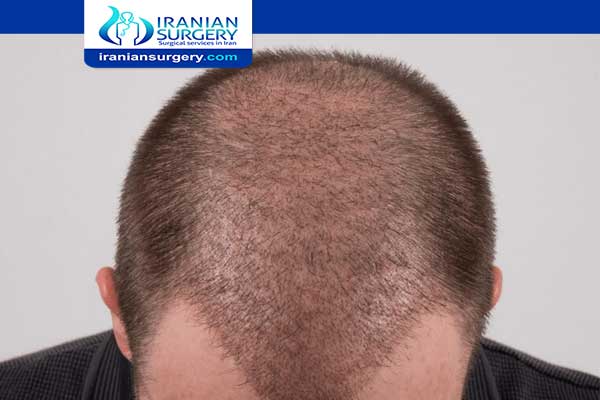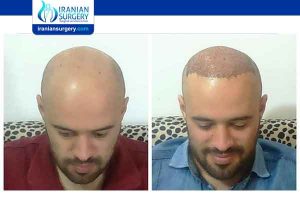Hair transplant growth stages

Hair Transplant Growth Stages
The cycle of Hair Growth after Hair Transplant Surgery
. Day 0: the day of the surgery is counted as day 0.
. Day 1-5: The first 2 weeks after the hair transplant are the most critical ones. During the first 5 days, patients may experience swelling of the forehead and at the back of the head, which is the donor area. The skin may also look red at the areas where all the tiny incisions were made for the newly transplanted hairs. This redness usually resolves after the first week or 2. After only a few days, the donor area is no longer tender.
________________________________________________________________________________________
Plan your Hair transplant in Iran with the Best Hair transplant doctor.
Iranian Surgery is a medical tourism company in Iran that cooperates with the best Hair transplant doctors, specialists and Hair transplant clinics in Iran and offers world-class treatments at an affordable cost.
_________________________________________________________________________________________

Read more about : Hair transplant in Iran before and after
Read more about : Hair transplant surgery, Before and after procedure Video
Read more about : The German patient saved $ 14,000 by choosing Iran over Germany to have stomach liposuction and abdominoplasty surgery.
Read more about : The Swedish patient saved $ 90,000 by choosing Iran over the United States to have leg lengthening surgery.
. Days 6 – 10: At this point, patients no longer experience any swelling and the redness should only be faint or completely gone. For each follicular unit transplanted, a “crust” will form which is the attached skin layer drying out. This scab can be gently removed by soaking and gentle rubbing with fingers. By day 10, all the crusting should be gone and the transplanted hairs will appear like a “crew-cut” haircut.
. Week 2- 3: The transplanted hairs will start to shed at this point, and by the end of the 3rd/4th week, most will be gone. This is a normal part of the healing process and is totally expected. The newly transplanted hairs go through a shedding process as the actual hair shaft is released, but the actual follicular unit and bulb are totally intact starting to grow a new hair shaft. Patients may feel like the operation was a failure but this is part of the normal hair cycle.
. End of Month 1 – Month 2: The hair follicles have entered into the resting phase of their cycle. The length of the resting phase can vary before they start to grow again. At this stage, patients will appear exactly as they did prior to surgery with regards to the amount of hair present.
. Months 2 – 4: The new hairs should start coming out. For some patients, their transplanted hairs start growing early in the timeline; for others, they start growing later. Patients will see the new transplants, but they will be thin at this stage as they begin to emerge from the scalp. Most of the native hair will be growing back at this time. The donor area is healing and any redness at the donor site will resolve.
Read more about : What is the success rate of hair transplant?
. Month 6: Transplanted hair has entered the anagen phase and begins to grow (finally…progress!). At this point usually, the doctor used to see you in follow up.
. Months 6 – 9: Patients will start to see a considerable amount of hair emerging from the scalp. The hairs are thinner; many of the transplanted hairs will be over 3 inches or longer and is able to be groomed. Toward the end of this period, the hair will show textural changes and start to thicken up. The donor area will be completely healed at this point. The original donor laxity is restored by month 9.
. 1 Year: Patients have achieved about 80% of the hair growth of the transplanted hairs. Most of the hairs will have emerged from the scalp. At this point, further density is unlikely to noticeably improve without further surgical and/or nonsurgical intervention (PRP). It’s time to focus on outcome maintenance!
. After 1 year: For some patients, they achieve the full appearance by 1 year; others will take longer for the hairs to emerge and increase their density and thickness.
Additionally, as the hair grows longer, that provides a fuller appearance since the volume of hair is increased at the transplanted area.
Read more about : Long-term side effects of hair transplant surgery
About Iranian Surgery
Iranian surgery is an online medical tourism platform where you can find the best hair transplant doctors in Iran. The price of a hair transplant in Iran can vary according to each individual’s case and will be determined based on photos, a number of grafts a patient needs and an in-person assessment with the doctor. It is our responsibility to give you enough information about this surgery, so that please feel free to contact us and get free consultation from Iranian surgery.
Read more about: forehead reduction without surgery
Read more about: Pre Hair Transplant procedure
Read more about: Hair transplant cost
Read more about: forehead reduction surgery
- Hair transplant in Iran
- Cost of hair transplant in Iran
- Hair transplant cost
- Hair transplant in Iran for female
- Pre-hair transplant in Iran
- Hair transplant recovery
- Follicular Unit Transplant (FUT) in Iran
- Follicular unit extraction (FUE)
- Can hair transplant fail
- Best hair transplant method
- Hair transplant in shiraz
- Hair transplant before and after
- Hair transplant surgery
- Beard transplant
- Is hair transplant permanent
- Hair transplant side effects
- Hair transplant without shaving
- Hair transplant growth
- Plastic surgery in Iran
- Rhinoplasty
- Liposuction
- Abdominoplasty (tummy tuck)
- Face lift
- Hair transplant for male
- Blepharoplasty
- Breast Augmentation
- Breast implant
- Breast Lift
- male breast reduction ( gynecomastia )
- Body sculpting
- Brazilian Butt Lift
- Facial plastic surgery
- Lip augmentation
- Ear pinning
- Neck lift surgery
- Chin lift surgery
- Arm Lift
- sex reassignment surgery ( sex change )
- Vaginoplasty
- labiaplasty
- Female hair transplant
- Reconstructive surgery
- Septoplasty
- Breast reconstruction
- Breast reduction
- Cleft lip and palate repair


6 Comments
After how many time we can dye hairs after transplant?
hello. After Hair transplant you have to be careful, Exposing hair to harsh chemicals, bleaching agents, and peroxides might irritate the scalp and impair your newly implanted grafts, thereby hampering the recovery process and the transplanted hair quality. Therefore, it is advised to wait for about four to six weeks before dying or coloring your hair
I would be happy if you can help me. I have some questions about FUE hair transplant but my most important one is how do the stages after FUE hair transplant look like (better to say how would my hair growth stages would be like)?
Regards Ibraham
About 10 to 20% hair growth is observed in 3 to 4 months after hair transplant. You can see about 50% hair growth after hair transplant over the next six months. 80% results that you can see after 8 to 9 months. One can see 100% of hair transplant results in 9 to 12 months after FUE
Can you tell me how long after I do a hair transplant I could see the full result of my hair growing and I no longer have boldness? like I need a timetable.
Hello this is Iranian Surgery. Thank you for your comment. As you have asked the results of hair transplants are not instantaneous, and there is a specific pattern of growth and a specific timeline that must all be followed to see the final result. After the successful hair transplant operation, it is time to go through the recovery period; However, first of all, it should be borne in mind that achieving the ideal result after hair transplantation requires patience because hair to grow and reach a natural state must have certain steps called “Hair growth cycle after transplantation” Hair ”to go through completely. For a week, you should take care of the wounds created in the areas of the hair bank and the area where the hair is received. During this period he will see skin inflammation, pain, itching, scaling, and the like. The period of hair growth after hair transplantation starts again after about a week and the wounds are healed. Hair growth continues until the third week after normal hair implantation, after which it begins to fall out suddenly. This stage, which is known as fall shock, causes anxiety in many people. The follicular shock phase not only has no cause for concern but also indicates that the implanted hair is growing properly. From about the ninth month onwards, the hair becomes completely normal and continues to grow. For more information, you could read the article on our site https://iraniansurgery.com/en/hair-transplant-growth-stages/